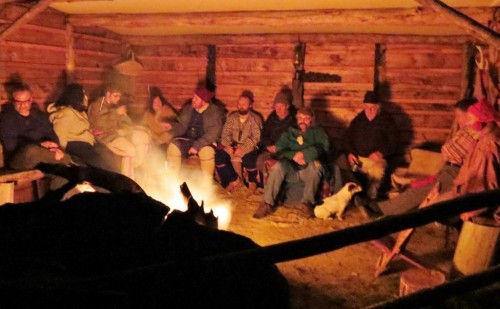Vol. 46, November 2013
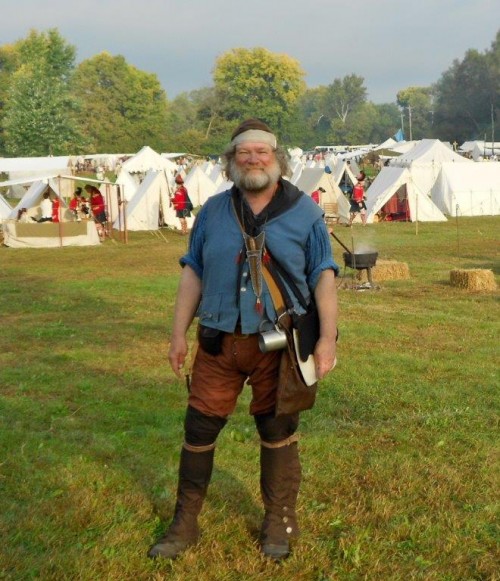
Newsletter writers have lots of good days and occasionally some of the other kind. One needs to be watchful for fear the latter turn into weeks or longer. Seems I got lost somewhere around the traps, or at least fearsome confused and simply unable to settle at the computer. Writer’s block someone called it. Then, losing my faithful little Jack Russell terrier through tumours in the spleen and kidneys really dampened my spirits.
George Mohr helped lift me out of my doldrums with mention that he and Kay had just returned from rendezvousing in the States. George kindly forwarded a couple of photos while his observations below helped to inspire me to knuckle down to this overdue edition.
From George :-
“The lead photo was taken at the Feast of the Hunter’s Moon in Indiana. The others were from the Eastern Primitive in Pennsylvania. We had a great time at both events. The Feast has been going for over 30 years. It is part festival, part rendezvous, part educational event on colonial and Indian arts, crafts, manner of living, music, etc…
It’s a huge event! They get over 40,000 people through on the weekend. There are lots of different foods, entertainments, highland games, lacrosse games with Indians vs. anyone. It is actually one of the top ten festivals in the United States.
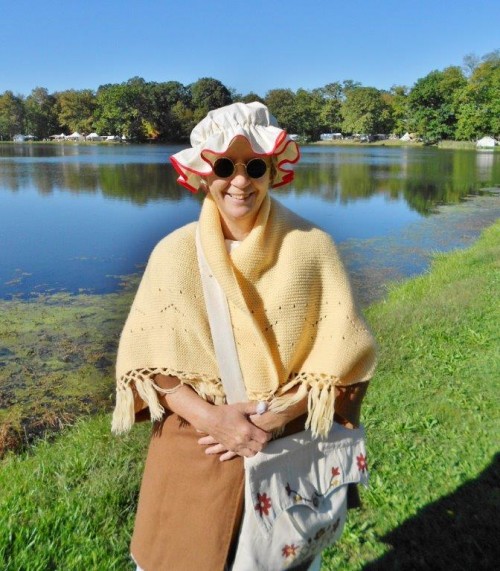
The Eastern was set around a nice lake in western Pennsylvania, with camps all around the lake, 700-1000 participants. We went during the week when only rendezvous participants were there. As usual, the general public was allowed in for the first weekend. We were there from Monday to Thursday.
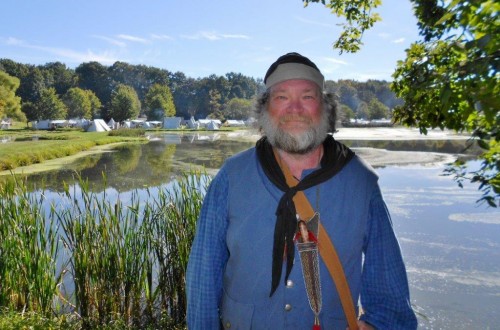
Surprisingly, the primitive archery was probably more popular than the black powder shooting. They had a great archery course set out through the woods, shooting at all sorts of lifelike animal targets. Lots of trade goods of all sorts, both big trader tents and trade blankets.
The fry bread was something else! It was sort of like a big fried donut with a choice of all kinds of different fillings, made fresh in about two minutes. Wonderful! And then there was Burrito Bob. When Bob cooked up a bunch of fresh burritos, he went around the camp beating on a frying pan to tell everyone the burritos were fresh and hot. It was a great experience.
The weather, especially at the Eastern, was about perfect. There was rain on Sunday at the Feast, but it cleared by lunchtime. We hauled raingear, and I even carried the gear in my snapsack one day, but never had to put the oilskins on. It doesn’t get much better than that. I’m glad we didn’t go to the Black Hills. Deadwood got four feet of snow in one storm. Regards to all.” George
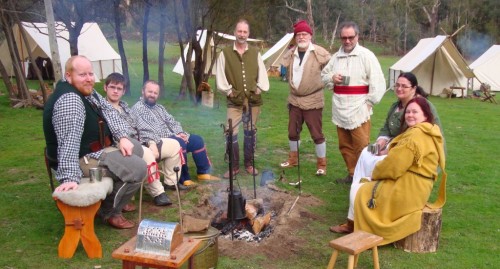
Meanwhile, back home in the Victorian central highlands,
our September rendezvous was a relative modest and quiet celebration of all that a Rondyvoo should be. Black powder plinking fun or a time of serious shooting concentration, a chance to whoop it up in the evenings, a drop of fire water, a scattering of bulldust, some fine song and story-telling, followed by late evening deep and meaningful thinking whilst staring into the flames of radiant campfires.
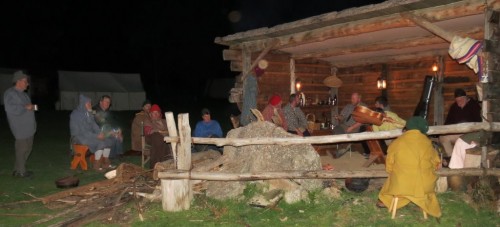
Attending at this rondy were Michelle Barraclough, John Sultana, Jenny and Gary Baker, Murray and Peter Convey, Jim Walker, Robert and Kurt Powell, Cam Cowled, Tom Jefferies, Chook Fowler, John Morland, Ian Convey, Mark Pountney, Bob Ellis and Ron Davis. A total of just seventeen pilgrims attending in twelve primitive camps, and the authenticity levels of those camps was very good, only……….
Er, well, your Committee really stuffed up in regards to authenticity this time. A last minute decision was made to purchase three bottles of Rusty Gun port and three blocks of chocolate for prizes to competition winners. And whose idea was it? Yours truly, none other! Nice, but so wrong! See our picture gallery – you might notice our SCFT logo labels on the screw-top bottles. Yes, screw-top bottles! You might also notice the electric blue “modern packaging” of the chocolate blocks. We will do better.
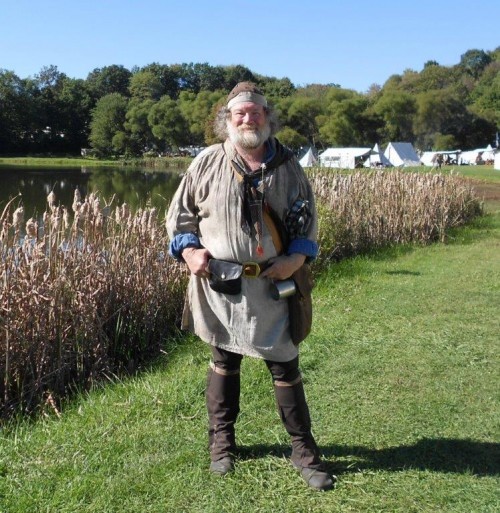
Ramrods:
Wiping sticks, loading rods, ramrods, call them what you will, but a muzzleloader is useless without one of the correct size. A ramrod for a given firearm should be long enough to touch the face of the breech plug and have one inch, or a little more, sticking out of the muzzle; you might get away with one slightly shorter.
For maximum strength the ramrod should be as big in diameter as you can fit in the bore, but small enough to fit under the barrel without making the gun look like an under and over. . 40cal. and above should be at least 3/8” Dia. And up to ½”D in the larger usually smooth bores. The large rods in the old days were usually tapered with the small end going under the breech end of the stock; this is a very practical method of maintaining maximum strength with minimum bulk in the stock.
Of course these diameters are for wooden ramrods, metal rods (steel) can be considerably smaller “a la” military guns.
The best wood for wooden rods is split hickory, if you can get it, but to be practical, selected Tasmanian Oak or Mountain Ash dowelling is okay. Of course a steel rod either hollow or solid is a lot stronger. I have seen ramrods made from brass tube, hardened copper tube, even aluminium but these are not traditional for pre 1840 era.
There are also plastic ramrods available, no comment, and ones made of fibreglass which should be avoided at all cost as the fibreglass will file the crown off the muzzle and thus the accuracy of you gun quick smart.
Most wooden rods are usually tipped with brass sleeves from 1” to 2” long on each end but can and often were just left plain wood. Brass end sleeves can vary from plain to those that are threaded for cleaning and maintenance tools and often cross-drilled to take a T handle. The sleeve should be pinned to the rod and all exposed edges rounded off.
I select my wood ramrod stock from the local hardware store- Tas. Oak dowel and pick the length with the straightest grain then cut them to just over the correct length. I then place them in a piece of PVC pipe that has one end blanked off. This pipe is then filled with a 50/50 mixture of boiled linseed oil and kerosene. You have to wedge the rods in with a piece of scrap wood to stop the rods floating up.
The rods are left to soak for 3 months or more then I make a new ramrod by firstly wiping off all oil mix and then sanding down by hand to the diameter required and then cutting to the correct length and fitting sleeves if required.
It’s not a bad idea to have one or two blank rods soaking, as just described, because you will break a rod now and then and it doesn’t take so long to make a replacement. Rods soaked in the oil and kero mixture are more durable. WYTK Ian Convey
Tattler:
Tattler’s column was originally meant to indicate any anomalies to our code in a humorous, understandable, but nice way. So that we all benefit, learning by our mistakes with opportunity to correct those usually “non-period” items of apparel, utensils and such. Well, your committee and I really blew it at our September rendezvous. We haven’t tried to cover up though. See if you can spot areas where we went wrong by examining our gallery photos.
Charlie Timma has kindly supplied a selection of his pencil portraits of members for inclusion over the upcoming volumes. Copies were available (via Chook) to members at last camp.
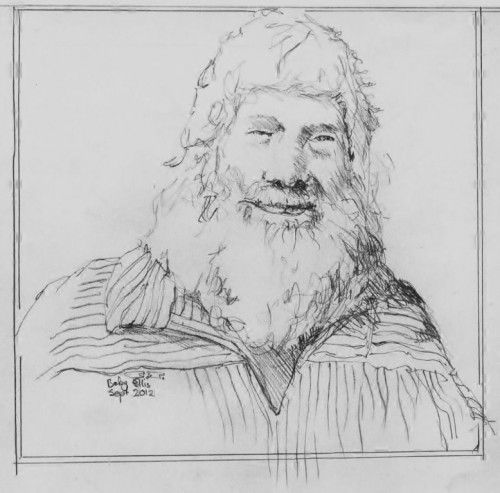
Handy Hint:
Small calico bags with sewn on tapes for closure are mighty handy for hidden storage of bread or other items that you may wish to keep in the original but non period store-bought packaging against spoilage or to prevent contamination.
Home Brew:
There’s no doubt that quaffing yeasty home-brews can lead to some fascinating discoveries. Home Brewers talk seriously about their beer but one can’t deny their sense of humour. Clive and Veronica Brown have delved into the mysteries of chemistry, researched the wonders of home brewing, and now share this little “gem” of an article revealed in a Chemistry Journal of 1839, a copy of which might, or might not, have found its way across the wilderness to the Green River rendezvous.
“The Secret of the Fermentation Process: Beer yeast, when dispersed in water, breaks down into an infinite number of small spheres. If these spheres are transferred to an aqueous solution of sugar they develop into small animals. They are endowed with a sort of suction trunk with which they gulp up the sugar from the solution. Digestion is immediately and clearly recognisable because of the discharge of excrements. These animals evacuate ethyl alcohol from their bowels and carbon dioxide from their urinary organs.
Thus one can observe how a specifically lighter fluid is extruded from the anus and rises vertically whereas a stream of carbon dioxide is ejected at very short intervals from their enormously large genitals.”
“Still thirsty?” asks Veronica. You needed to know this chemistry secret, didn’t you?
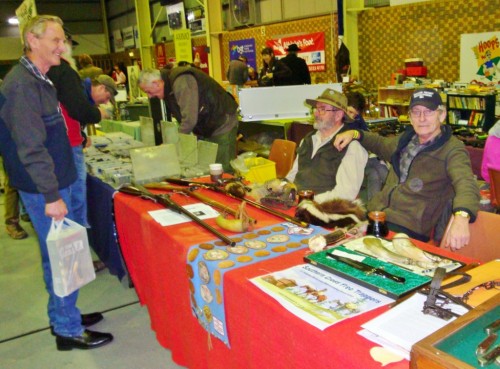
After my restoration of the 45 cal Trade rifle, as told in “Around the Traps, Vol 44” a problem developed with frizzen and spring. On squeezing the trigger the rifle would fire but the frizzen would not open fully. I sought some advice from club flint guru Ian Convey. On inspection he found that the trouble was in the slot where the frizzen pivoted and on the bearing point where the spring put pressure on the underside.
Now to dismantle frizzen and spring, and get to work with a small oilstone to get some clearance in the lock, also round off the bearing surface which had a small flat on the bottom where the spring touched. Working very slowly with much testing and trials with reassembly as the job progressed, finally I was satisfied with the outcome; then to a final test of trigger and frizzen – and success!
The results were much better and the lock gave stronger sparks, for the frizzen now flies fully open, letting the flint travel the full length of the face. Hopefully this will mean a longer life for the flint, as now it will not be driven into the face of the frizzen. Thanks to Ian for the info on how to do these adjustments Trapper Jim
